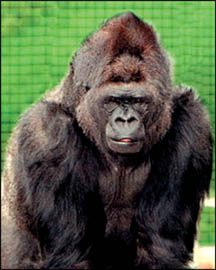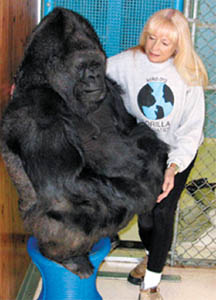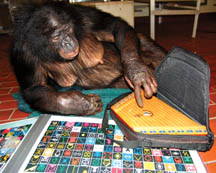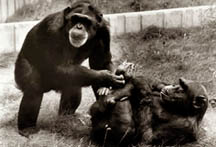|
observer |
|
|
|
|
|
OTHER LINKS |

|

|

|
|
|
|
|
Even though the anatomy of their throats is not designed to vocalise sound in the way humans can, the great apes are being taught to communicate today using sign language. A modified version of American Sign Language, also known as Ameslan or ASL, which is normally used by those whose hearing is impaired, is now used to communicate with our 'dumb' friends in the animal kingdom. Chimpanzees, gorillas and even orangutans have shown great ability in learning the sign language.
Can primates really communicate with humans using sign language, is a moot question (a matter about which there may be disagreement or uncertainty).
Attempts to communicate with our closest animal relatives began way back in the 60's, with chimpanzees. One of the chimps who became famous for learning ASL in the early days is Washoe. In fact, Washoe created history by becoming the first non-human to communicate directly with humans, using a language made by humans.
Washoe's training was undertaken by two psychologists - Professor Allen Gardner and his research associate Beatrice, who was also his wife. In the first phase of this long-term project, which began in 1966 and ended in 1970, Washoe had learned more than 130 signs. Having picked up the signs at a slow pace initially, Washoe had proved her skill at the language by learning to even coin words and make phrases.
|
|
According to her trainers, she showed an ability to lie, joke and even display anger, through the signs she used. They claim in their research reports that Washoe who once had a confrontation with a macaque monkey, showed her dislike towards this macaque, on another occasion when they met again, by signing the words "dirty monkey."
Washoe had also displayed the capability of passing on what she had learned to her offspring. After her own baby had died, she had been given another orphaned chimp baby to look after. Washoe had started to teach the baby named Loulis sign language, once she accepted the new chimp as her own.
Washoe, the chimp may have created history as the first chimp to actually learn sign language, but guess who takes the limelight today as the primate who is skilled in ASL? A lowland gorilla named Koko who first began her training more than two decades (twenty years) ago, when she was just a baby!
A resident of the Gorilla Foundation in the suburbs of San Francisco, California, Koko has today become a star. She has inspired a best-selling novel, a film, exhibited her own art work, appeared on multiple television specials and news programmes, being featured in magazines, and appeared on the covers of international magazines, such as the National Geographic (1978, 1985). Her latest achievement is hosting an internet chat session. Koko even has her own personal computer. Isn't that truly amazing?
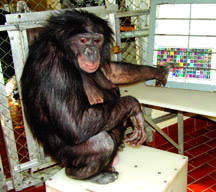
Koko's trainer Dr. Penny Patterson claims that she is very intelligent and has a vocabulary of over 1000 signs and understands nearly 2000 words of spoken English. When Koko was subject to an IQ test, she had obtained a surprising score of 90 points. Don't you think it would be a wonderful experience to meet this great talking ape and have a 'chat' with her? Perhaps you could do so the next time Koko decides to have an internet chat session.
According to Dr. Patterson, Koko has revealed much of her personality through ASL. With the help of pictographs representing different emotional states, Koko is capable of following a conversation and even arguing. Like Washoe, the chimp, Koko too has displayed ability to joke and even lie. She has also developed a strong bond with kittens and is famous for her heart-warming relationship with them.
Today, Koko has become the most articulate. (able to explain or express thoughts or feelings clearly in words - in Kokos case in signs) female gorilla in the world. And therefore, naturally she has been selected to become the ambassador for her critically endangered species.
|
|
It is hoped that once people come to know Koko and realize how intelligent and human-like the gorillas and other primates are, through her, they will be more protective of the species.
Koko is indeed amazing when it comes to communicating in sign language, but she's not the only one who is being trained to communicate with humans. A young orang-utan named Cody from a zoo in England is also recorded to have proved his ability to communicate, voicing several different one-syllable sounds, each with its own meaning.
In order to achieve this form of communication, where sounds are made, Cody's trainer had relied on a mode of speech used effectively with children who are autistic, (a mental condition in which a person cannot communicate or form relationships with others).
Despite wide criticism by scientists about the research into communicating with our closest animal relatives using human language, studies into this continue. And today, sign language is not the only means used; lexigrams and keyboards also play a vital role in teaching these apes to communicate with humans.
|
|
A pygmy chimp named Panbanisha at the Georgia State University in Atlanta, who had acquired a vocabulary of 3,000 words by mild-1999, had been introduced to a keyboard containing 4000 symbol-marked buttons. Each of these symbols represent a specific word or abstract concept such as 'give me' or 'good.' Each time Panbanisha 'types' these buttons, the words they represent appear on a screen and are spoken by a computer voice synthesizer.
Don't you think it's cool? And guess what? Panbanisha's trainers say she's so familiar with these symbols now, that she even tries to draw them on the floor using chalk. What's more amazing is that she's teaching her young son her reading and 'speaking' skills.
You may be surprised to learn that some of these relatives of ours have shown a great liking for art as a form of communication. And they are skilled enough to express themselves using pencils, felt-pens and paint.
What is significant is that the art work some of these apes like Congo the chimp (famous during the 1950s), or Betsy, another talented chimp have done are not just random scribblings. They have shown a personal, readily recognisable style and have even attracted genuine praise from reputed artists such as Pablo Picasso!
Now who says apes can't 'talk' or 'paint' for that matter? They may not be equal to humans, but they certainly are intelligent and skilled animals that need to be taken notice of.

